Thermal and Tribological Properties Enhancement of PVE Lubricant Modified with SiO2 and TiO2 Nanoparticles Additive
Abstract
1. Introduction
2. Experimental Methods
2.1. Nanolubricant Preparation and Stability Evaluation
2.2. Thermal Conductivity Measurement
2.3. Tribology Measurement
2.4. Uncertainty Analysis
3. Results and Discussion
3.1. Stability of Nanolubricants
3.2. Thermal Conductivity of Nanolubricants
3.3. Thermal Conductivity Regression Model Analysis
3.4. Frictional Properties
3.5. Wear Scar Analysis
4. Conclusions
Author Contributions
Funding
Institutional Review Board Statement
Informed Consent Statement
Data Availability Statement
Acknowledgments
Conflicts of Interest
References
- Kotia, A.; Rajkhowa, P.; Rao, G.S.; Ghosh, S.K. Thermophysical and tribological properties of nanolubricants: A review. Heat Mass Transf. 2018, 54, 3493–3508. [Google Scholar] [CrossRef]
- Holmberg, K.; Erdemir, A. Influence of tribology on global energy consumption, costs and emissions. Friction 2017, 5, 263–284. [Google Scholar] [CrossRef]
- Kamel, B.M.; El-Kashif, E.; Hoziefa, W.; Shiba, M.S.; Elshalakany, A. The effect of MWCNTs/GNs hybrid addition on the tribological and rheological properties of lubricating engine oil. J. Dispers. Sci. Technol. 2021, 42, 1811–1819. [Google Scholar] [CrossRef]
- Exxon-Mobil. 2019 Outlook for Energy: A Perspective to 2040; Exxon Mobil Corporation: Irving, TX, USA, 2019. [Google Scholar]
- Sharif, M.Z.; Azmi, W.H.; Redhwan, A.A.M.; Mamat, R.; Najafi, G. Energy saving in automotive air conditioning system performance using SiO2/PAG nanolubricants. J. Therm. Anal. Calorim. 2019, 135, 1285–1297. [Google Scholar] [CrossRef]
- Azmi, W.H.; Sharif, M.Z.; Yusof, T.M.; Mamat, R.; Redhwan, A.A.M. Potential of nanorefrigerant and nanolubricant on energy saving in refrigeration system—A review. Renew. Sustain. Energy Rev. 2017, 69, 415–428. [Google Scholar] [CrossRef]
- Azmi, W.H.; Hamid, K.A.; Usri, N.A.; Mamat, R.; Sharma, K.V. Heat transfer augmentation of ethylene glycol: Water nanofluids and applications—A review. Int. Commun. Heat Mass Transf. 2016, 75, 13–23. [Google Scholar] [CrossRef]
- Azmi, W.H.; Sharma, K.V.; Mamat, R.; Najafi, G.; Mohamad, M.S. The enhancement of effective thermal conductivity and effective dynamic viscosity of nanofluids—A review. Renew. Sustain. Energy Rev. 2016, 53, 1046–1058. [Google Scholar] [CrossRef]
- Wang, R.; Hao, B.; Xie, G.; Li, H. A refrigerating-system using HFC134a and mineral lubricant appended with N-TiO2 as working fluids. In Proceedings of the 4th International Symposium on Heating, Ventilating and Air Conditioning, Beijing, China, 9–11 October 2003; pp. 888–892. [Google Scholar]
- Redhwan, A.A.M.; Azmi, W.H.; Sharif, M.Z.; Zawawi, N.N.M.; Zulkarnain, O.W.; Aminullah, A.R.M. The effect of Al2O3/PAG nanolubricant towards automotive air conditioning (AAC) power consumption. In Proceedings of the Symposium on Energy Systems 2019, Kuantan, Malaysia, 1–2 October 2019; p. 012056. [Google Scholar]
- Yang, S.; Cui, X.; Zhou, Y.; Chen, C. Study on the effect of graphene nanosheets refrigerant oil on domestic refrigerator performance. Int. J. Refrig.-Rev. Int. Froid 2020, 110, 187–195. [Google Scholar] [CrossRef]
- Saravanan, A.L.; Lal, D.M.; Selvam, C. Experimental Investigation on the Performance of Condenser for Charge Reduction of HC-290 in a Split Air-Conditioning System. Heat Transf. Eng. 2020, 41, 1499–1511. [Google Scholar] [CrossRef]
- Sharif, M.Z.; Azmi, W.H.; Redhwan, A.A.M.; Mamat, R. Investigation of thermal conductivity and viscosity of Al2O3/PAG nanolubricant for application in automotive air conditioning system. Int. J. Refrig. 2016, 70, 93–102. [Google Scholar] [CrossRef]
- Masuda, H.; Ebata, A.; Teramae, K.; Hishinuma, N. Alteration of thermal conductivity and viscosity of liquid by dispersing ultra-fine particles. Dispersion of Al2O3, SiO2 and TiO2 ultra-fine particles. Netsu Bussei 1993, 7, 227–233. [Google Scholar] [CrossRef]
- Choi, S.U.S.; Eastman, J.A. Enhancing thermal conductivity of fluids with nanoparticles. In Proceedings of the ASME International Mechanical Engineering Congress & Exposition, San Francisco, CA, USA, 12–17 November 1995. [Google Scholar]
- Nikitin, D.; Zhelezny, V.; Prihodchenko, N.; Ivchenko, D. Surface Tension, Viscosity, and Thermal Conductivity of Nanolubricants and Vapor Pressure of Refrigerant/Nanolubricant Mixtures. Bocmoчнo-Eвponeйcкuй Жypнал Пepeдoвыx Texнoлoгuй 2011, 5, 12–17. [Google Scholar]
- Ouikhalfan, M.; Labihi, A.; Belaqziz, M.; Chehouani, H.; Benhamou, B.; Sarı, A.; Belfkira, A. Stability and thermal conductivity enhancement of aqueous nanofluid based on surfactant-modified TiO2. J. Dispers. Sci. Technol. 2020, 41, 374–382. [Google Scholar] [CrossRef]
- Redhwan, A.A.M.; Azmi, W.H.; Sharif, M.Z.; Mamat, R.; Zawawi, N.N.M. Comparative study of thermo-physical properties of SiO2 and Al2O3 nanoparticles dispersed in PAG lubricant. Appl. Therm. Eng. 2017, 116, 823–832. [Google Scholar] [CrossRef]
- Zawawi, N.N.M.; Azmi, W.H.; Redhwan, A.A.M.; Sharif, M.Z.; Sharma, K.V. Thermo-physical properties of Al2O3-SiO2/PAG composite nanolubricant for refrigeration system. Int. J. Refrig.-Rev. Int. Froid 2017, 80, 1–10. [Google Scholar] [CrossRef]
- Marcucci Pico, D.F.; da Silva, L.R.R.; Hernandez Mendoza, O.S.; Bandarra Filho, E.P. Experimental study on thermal and tribological performance of diamond nanolubricants applied to a refrigeration system using R32. Int. J. Heat Mass Transf. 2020, 152, 119493. [Google Scholar] [CrossRef]
- Kumar, R.S.; Narukulla, R.; Sharma, T. Comparative Effectiveness of Thermal Stability and Rheological Properties of Nanofluid of SiO2-TiO2 Nanocomposites for Oil Field Applications. Ind. Eng. Chem. Res. 2020, 59, 15768–15783. [Google Scholar] [CrossRef]
- Sanukrishna, S.S.; Shafi, M.; Murukan, M.; Jose Prakash, M. Effect of SiO2 nanoparticles on the heat transfer characteristics of refrigerant and tribological behaviour of lubricant. Powder Technol. 2019, 356, 39–49. [Google Scholar] [CrossRef]
- Sanukrishna, S.S.; Krishnakumar, T.S.; Vishnu, S.; Jose Prakash, M. Effect of oxide nanoparticles on the thermal, rheological and tribological behaviours of refrigerant compressor oil: An experimental investigation. Int. J. Refrig. 2018, 90, 32–45. [Google Scholar] [CrossRef]
- Zawawi, N.N.M.; Azmi, W.H.; Sharif, M.Z.; Shaiful, A.I.M. Composite nanolubricants in automotive air conditioning system: An investigation on its performance. In Proceedings of the 1st International Postgraduate Conference on Mechanical Engineering, Pekan, Malaysia, 31 October 2018; p. 012078. [Google Scholar]
- Zin, V.; Barison, S.; Agresti, F.; Colla, L.; Pagura, C.; Fabrizio, M. Improved tribological and thermal properties of lubricants by graphene based nano-additives. RSC Adv. 2016, 6, 59477–59486. [Google Scholar] [CrossRef]
- Idemitsu Kosan Co., Ltd. Characteristics of Daphne Hermetic Oil. Available online: www.idemitsu.com/business/lube/pve/daphne.html (accessed on 1 January 2020).
- Motozawa, M.; Makida, N.; Fukuta, M. Experimental Study on Physical Properties of CuO—PVE Nano-oil and its Mixture with Refrigerant. In Proceedings of the International Compressor Engineering Conference, West Lafayette, IN, USA, 9–12 July 2018. [Google Scholar]
- Matsumoto, T.; Kaneko, M.; Tamano, M. Properties of Polyvinylether (PVE) as a Lubricant for Air Conditioning systems with HFC Refrigerants? Data Update? In Proceedings of the International Refrigeration and Air Conditioning Conference, West Lafayette, IN, USA, 12–15 July 2010; pp. 1–8. [Google Scholar]
- Ismail, M.F.; Azmi, W.H.; Mamat, R.; Rahim, R.A. Rheological Behaviour and Thermal Conductivity of Polyvinyl Ether Lubricant Modified with SiO2-TiO2 Nanoparticles for Refrigeration System. Int. J. Refrig. 2022, 138, 118–132. [Google Scholar] [CrossRef]
- Ismail, M.F.; Wan Hamzah, W.A. Tribological Performance Effect of SiO2 and TiO2 Nanoparticles as Lubricating Oil Additives. In Proceedings of the 2nd Energy Security and Chemical Engineering Congress; Springer: Singapore, 2023; pp. 223–231. [Google Scholar]
- Hamisa, A.H.; Azmi, W.H.; Yusof, T.M.; Ismail, M.F.; Ramadhan, A.I. Rheological Properties of TiO2/POE Nanolubricant for Automotive Air-Conditioning System. J. Adv. Res. Fluid Mech. Therm. Sci. 2021, 90, 10–22. [Google Scholar] [CrossRef]
- Sharif, M.Z.; Azmi, W.H.; Zawawi, N.N.M.; Ghazali, M.F. Comparative air conditioning performance using SiO2 and Al2O3 nanolubricants operating with Hydrofluoroolefin-1234yf refrigerant. Appl. Therm. Eng. 2022, 205, 118053. [Google Scholar] [CrossRef]
- Sharif, M.Z.; Azmi, W.H.; Redhwan, A.A.M.; Zawawi, N.N.M. Preparation and stability of silicone dioxide dispersed in polyalkylene glycol based nanolubricants. In Proceedings of the MATEC Web of Conferences, Cyberjaya, Malaysia, 2–3 August 2016; p. 01049. [Google Scholar]
- Mostafizur, R.M.; Aziz, A.R.A.; Saidur, R.; Bhuiyan, M.H.U. Investigation on stability and viscosity of SiO2-CH3OH (methanol) nanofluids. Int. Commun. Heat Mass Transf. 2016, 72, 16–22. [Google Scholar] [CrossRef]
- Hongwu International Group Ltd. Anatase Nano TiO2 Titanium Dioxide Powders. Available online: www.hwnanomaterial.com/anatase-nano-tio2-titanium-dioxide-powders_p49.html (accessed on 25 September 2021).
- Beijing Deke Daojin Science and Technology Co., Ltd. Nano Silica. Available online: www.dknano.com/Ecplb.asp?Fid=1177&ClassId=1190&NewsId=2993 (accessed on 25 September 2021).
- Hamilton, R.L.; Crosser, O.K. Thermal conductivity of heterogeneous two-component systems. Ind. Eng. Chem. Fundam. 1962, 1, 187–191. [Google Scholar] [CrossRef]
- Wang, H.; Wang, Y.M. Tribological Performance of AlN nanoparticles as lubricating oil additive. Adv. Mater. Res. 2012, 366, 238–242. [Google Scholar] [CrossRef]
- Sanukrishna, S.S.; Vishnu, A.S.; Jose, M. Nanorefrigerants for energy efficient refrigeration systems. J. Mech. Sci. Technol. 2017, 31, 3993–4001. [Google Scholar] [CrossRef]
- Qing, S.H.; Rashmi, W.; Khalid, M.; Gupta, T.; Nabipoor, M.; Hajibeigy, M.T. Thermal conductivity and electrical properties of hybrid SiO2-graphene naphthenic mineral oil nanofluid as potential transformer oil. Mater. Res. Express 2017, 4, 015504. [Google Scholar] [CrossRef]
- Al-Janabi, A.S.; Hussin, M.; Jaafar, M.; Sharif, N.M. Stability and thermal conductivity of graphene in polyester nanolubricant. AIP Conf. Proc. 2020, 2267, 020066. [Google Scholar]
- Ghadimi, A.; Saidur, R.; Metselaar, H.S.C. A review of nanofluid stability properties and characterization in stationary conditions. Int. J. Heat Mass Transf. 2011, 54, 4051–4068. [Google Scholar] [CrossRef]
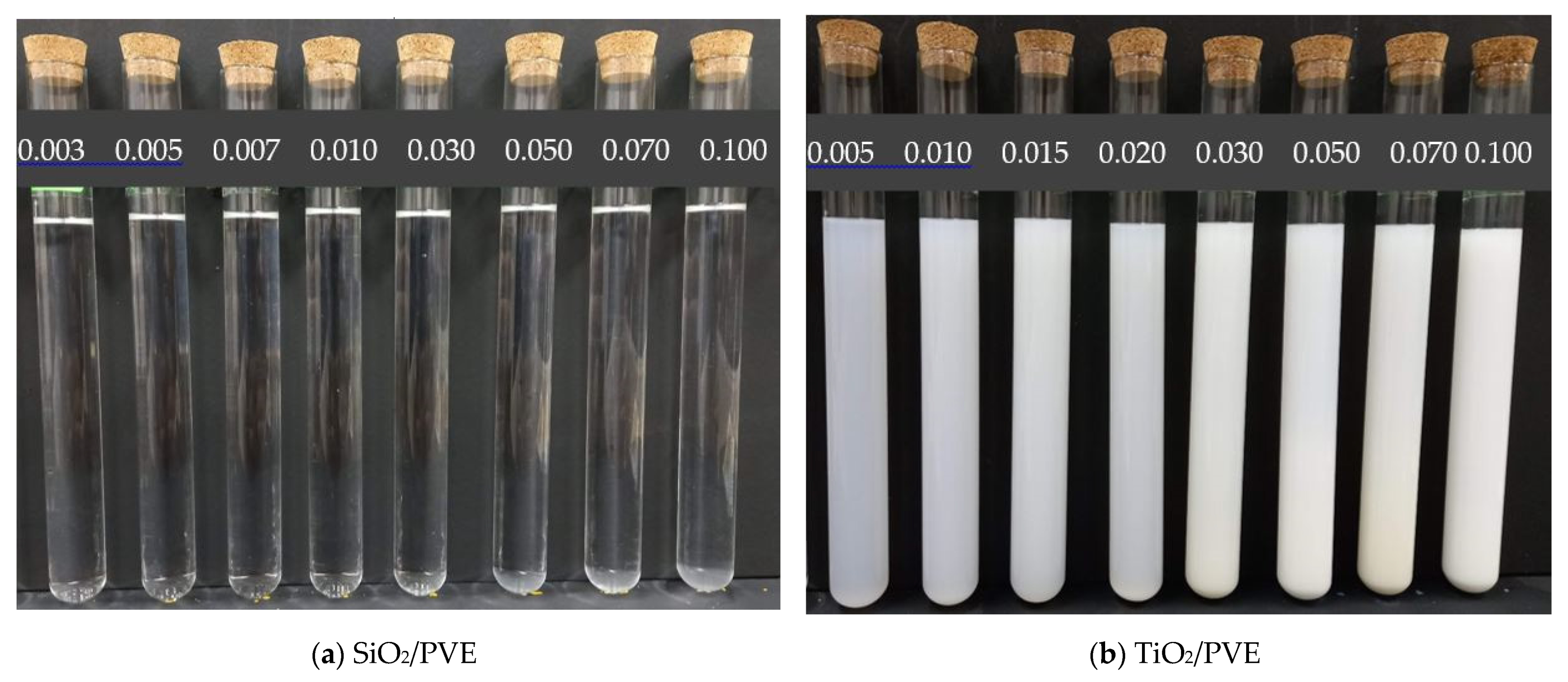
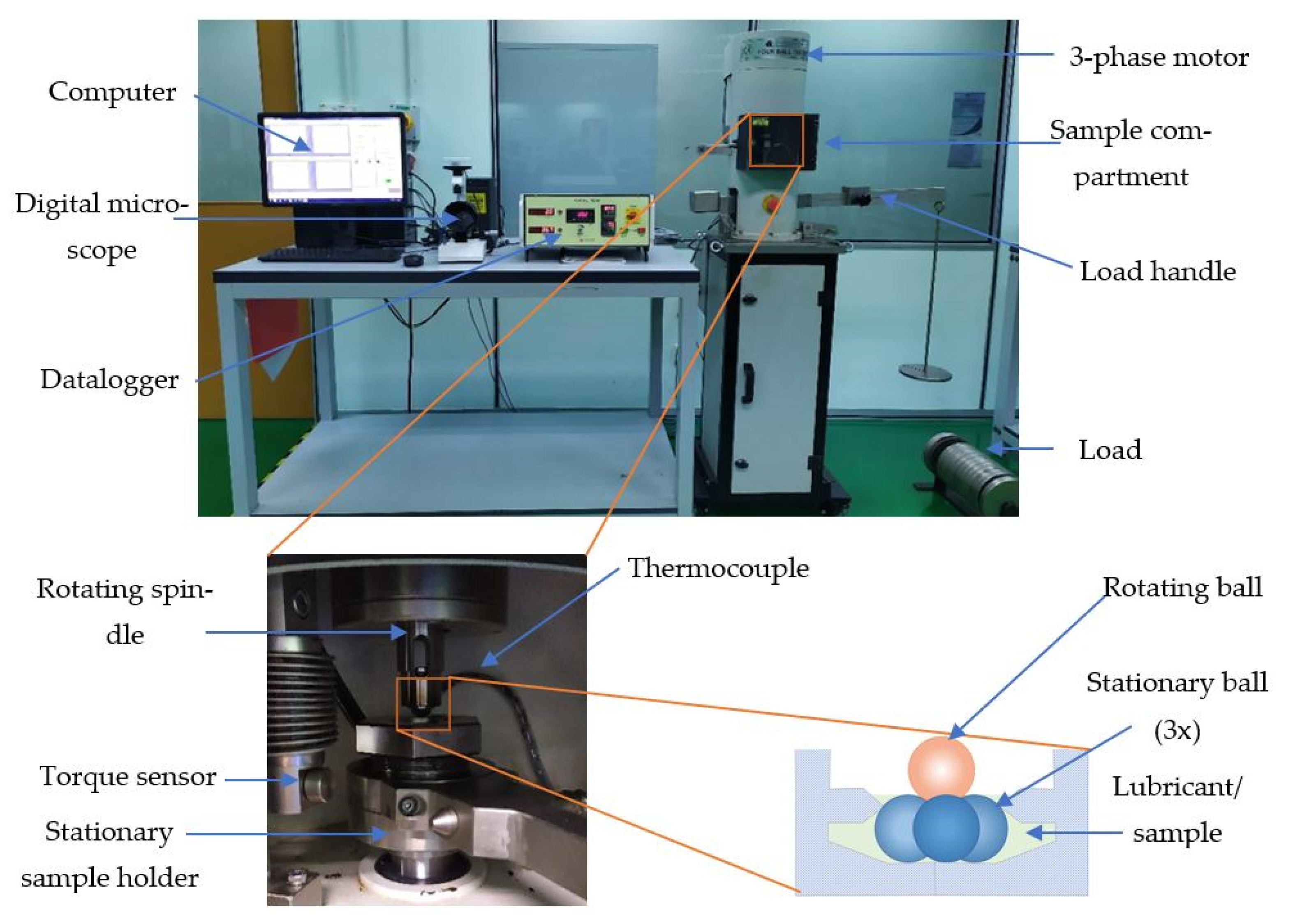

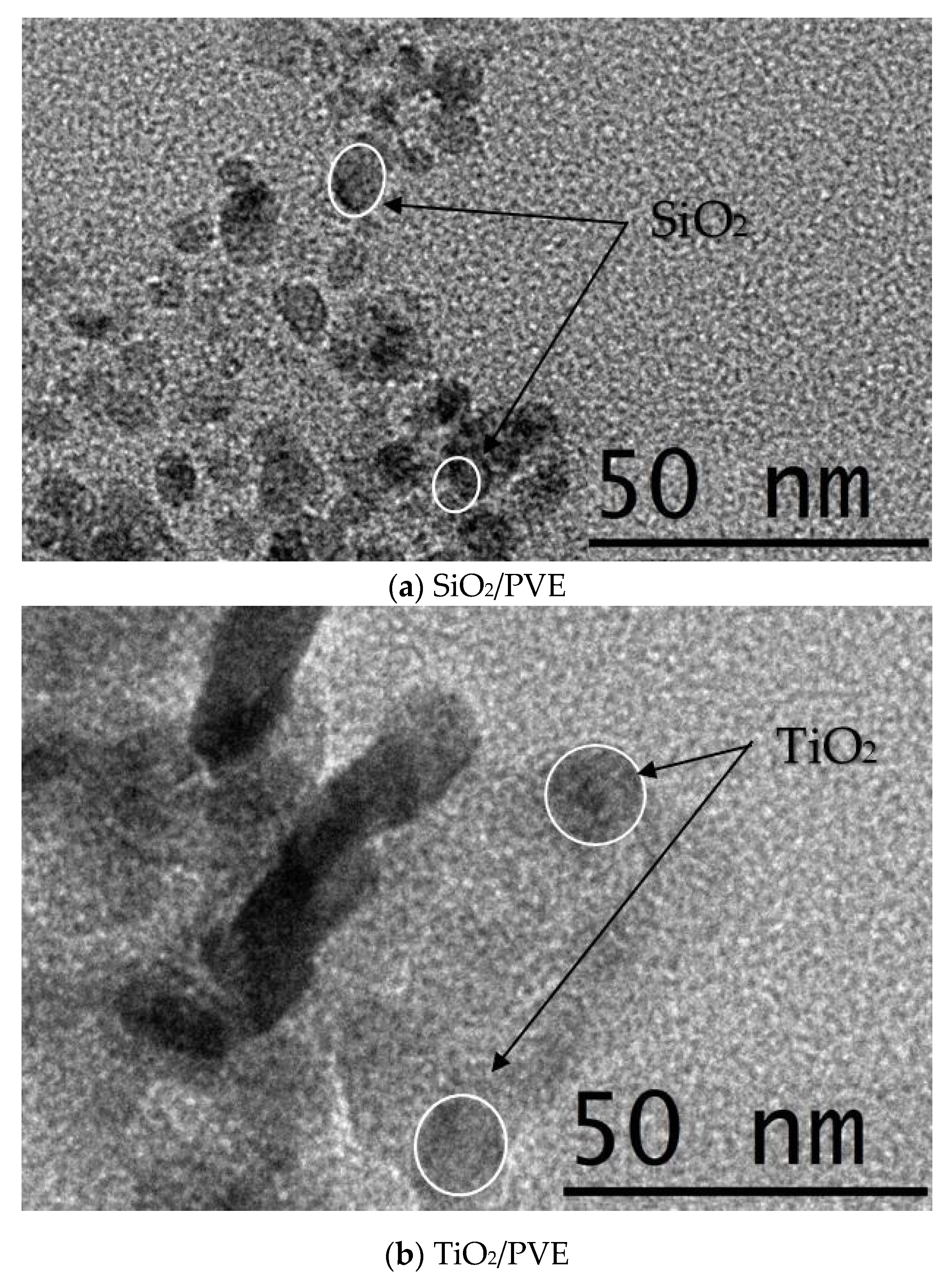
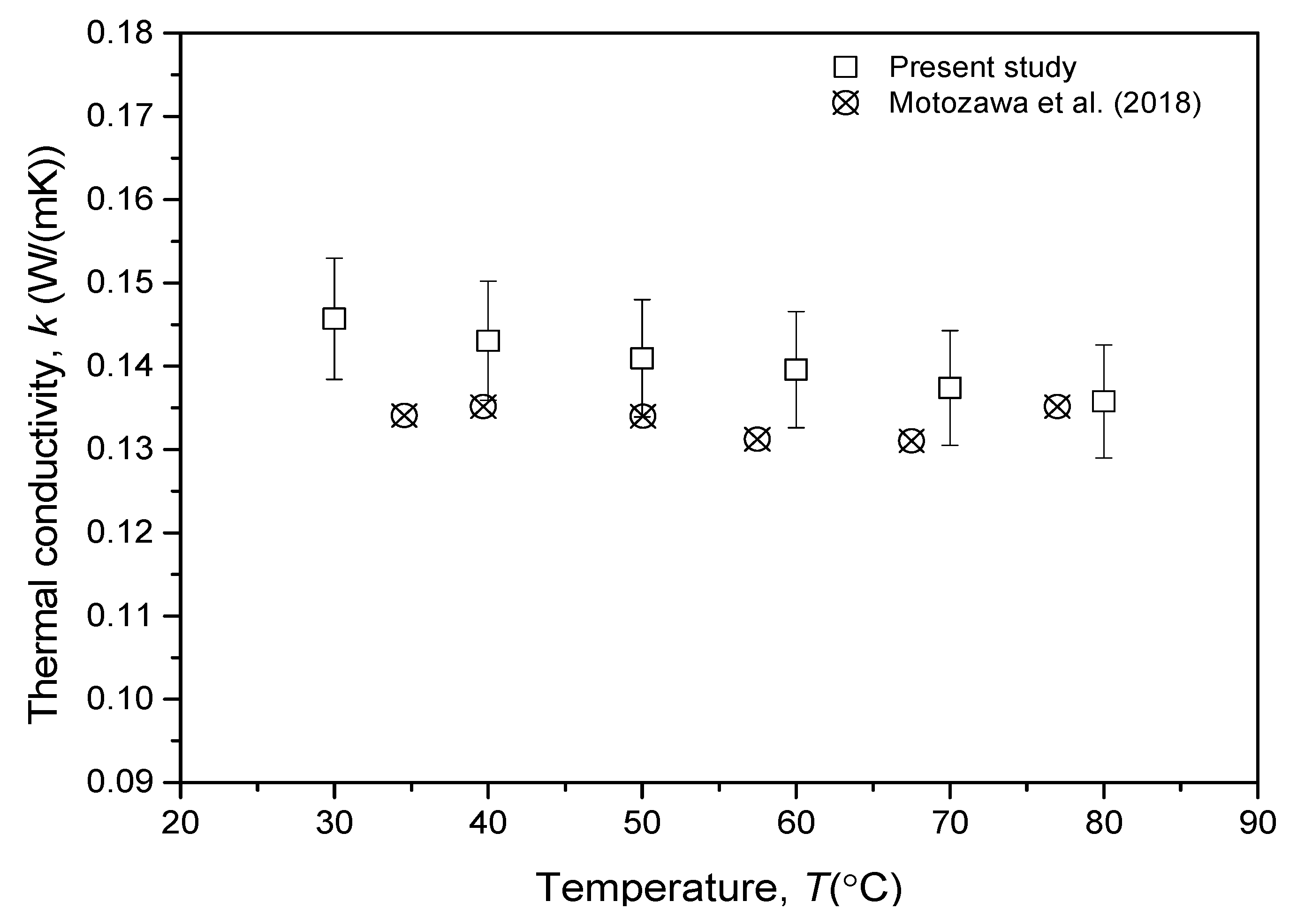
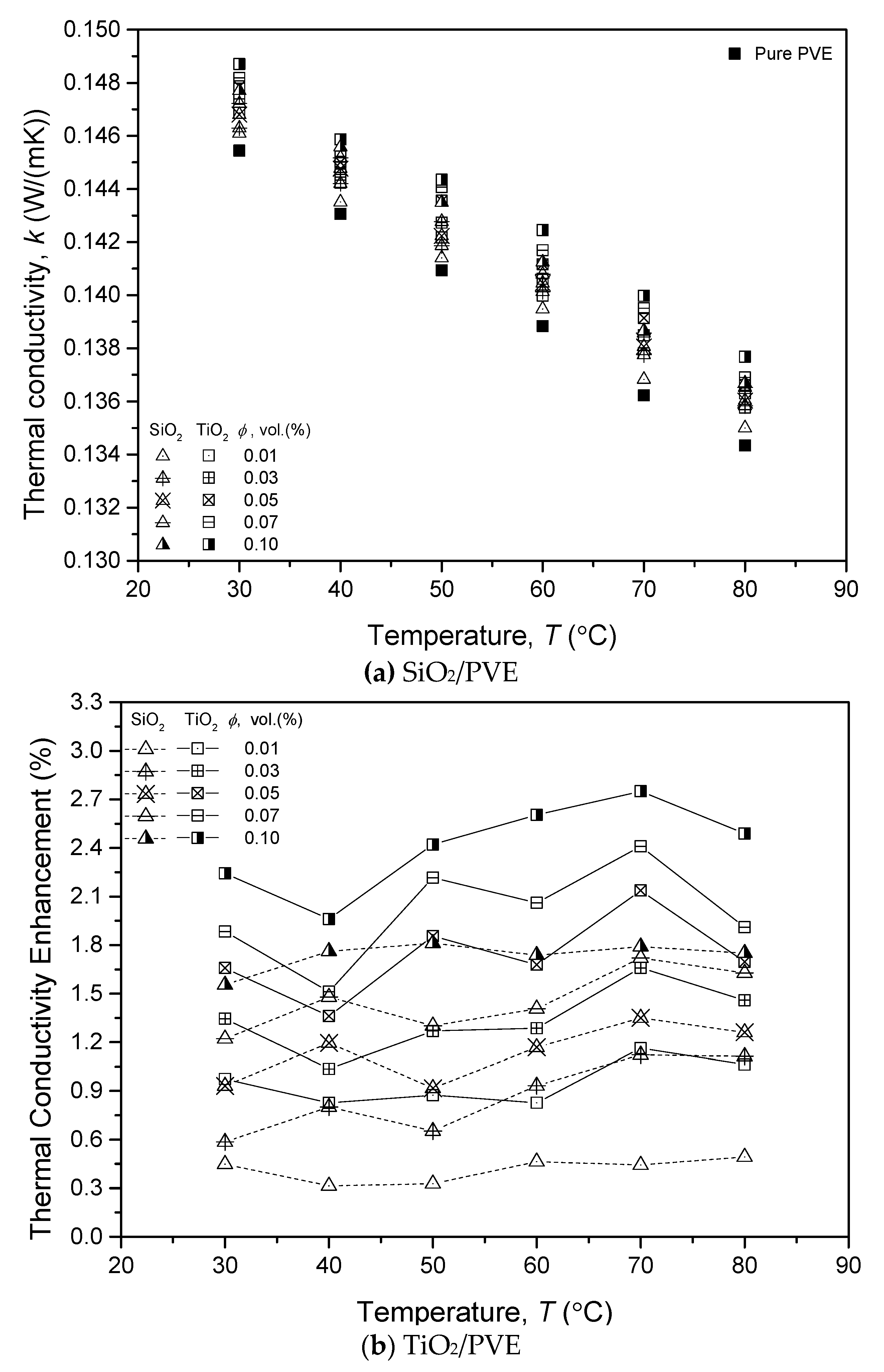

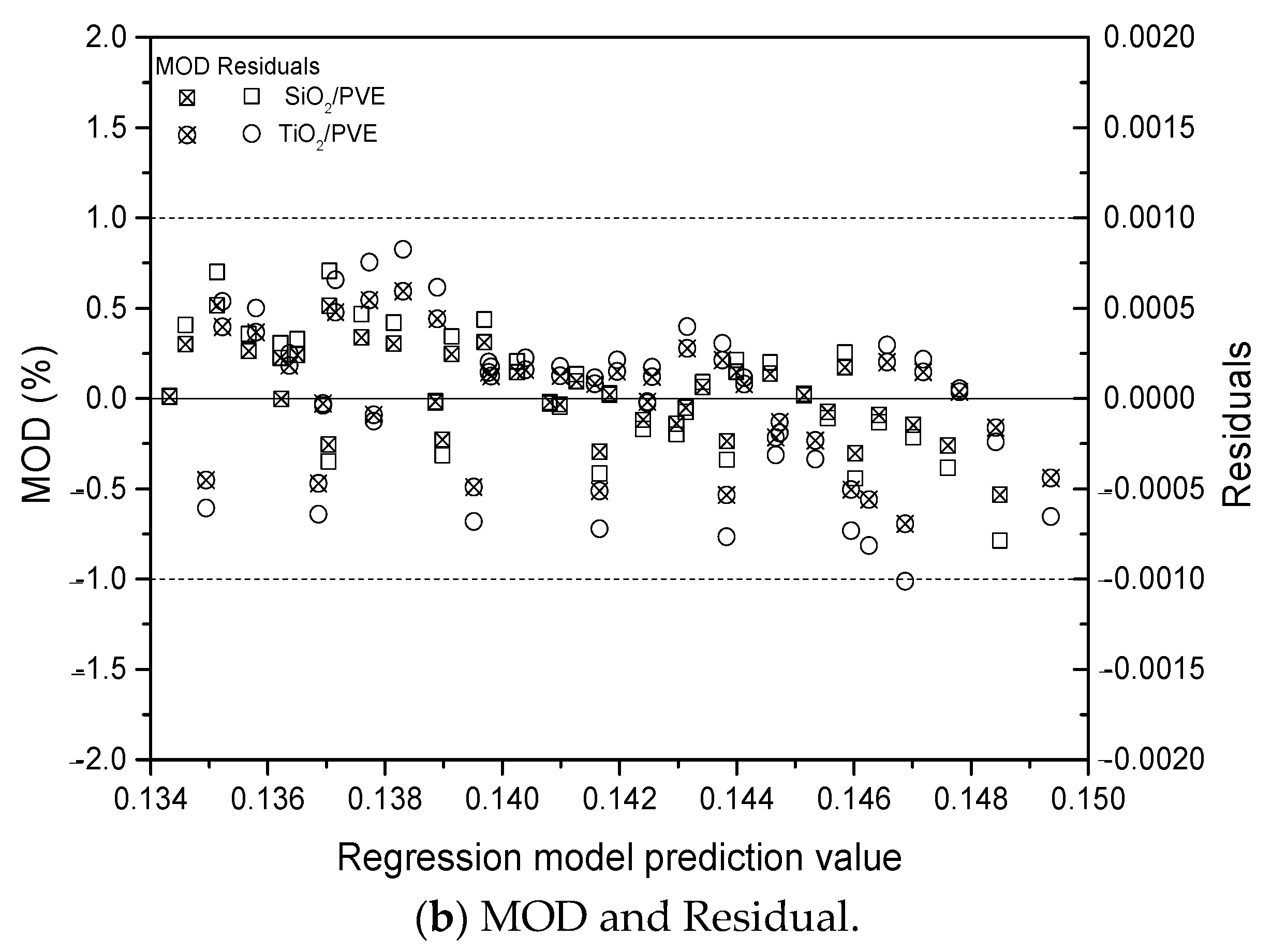

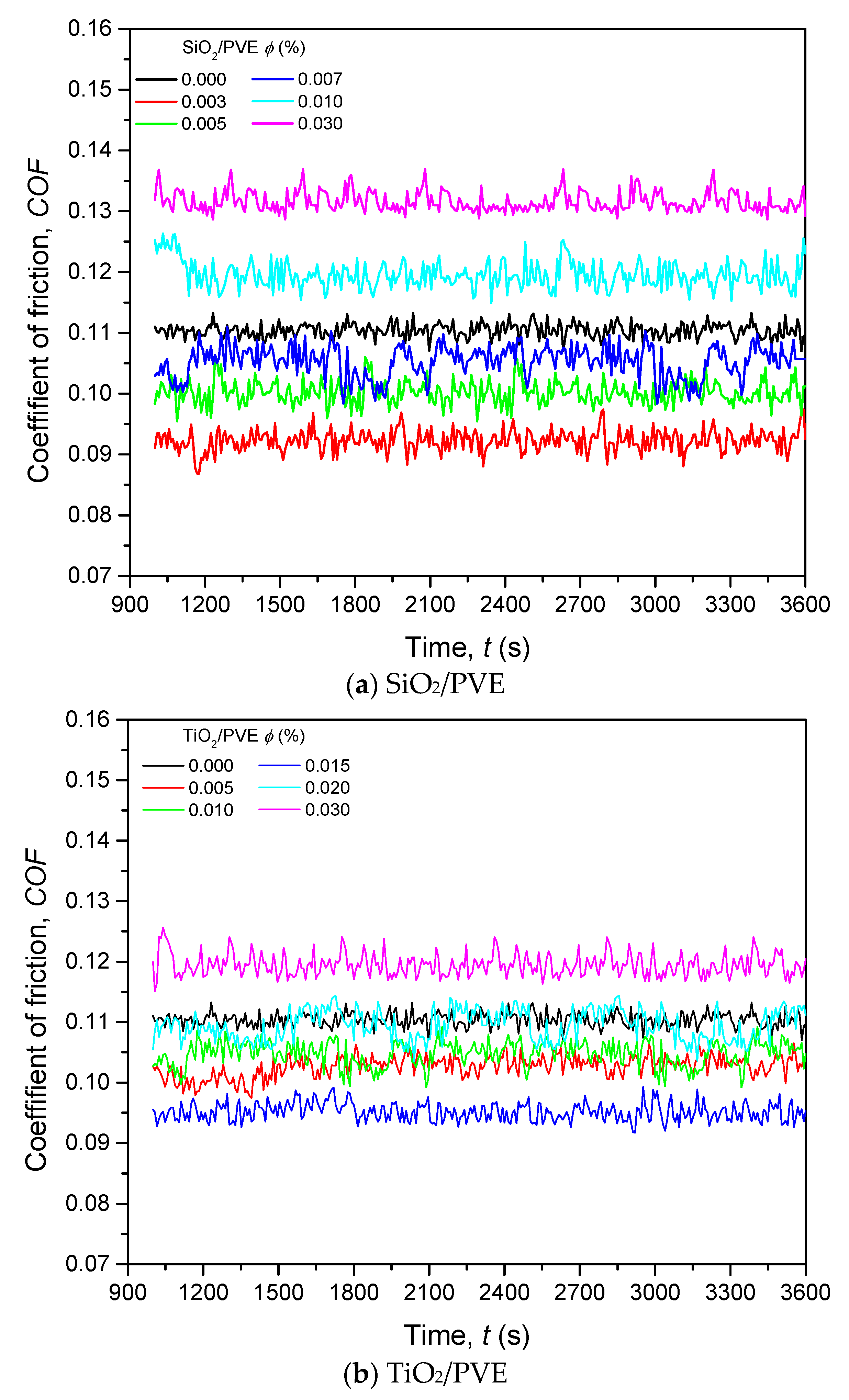
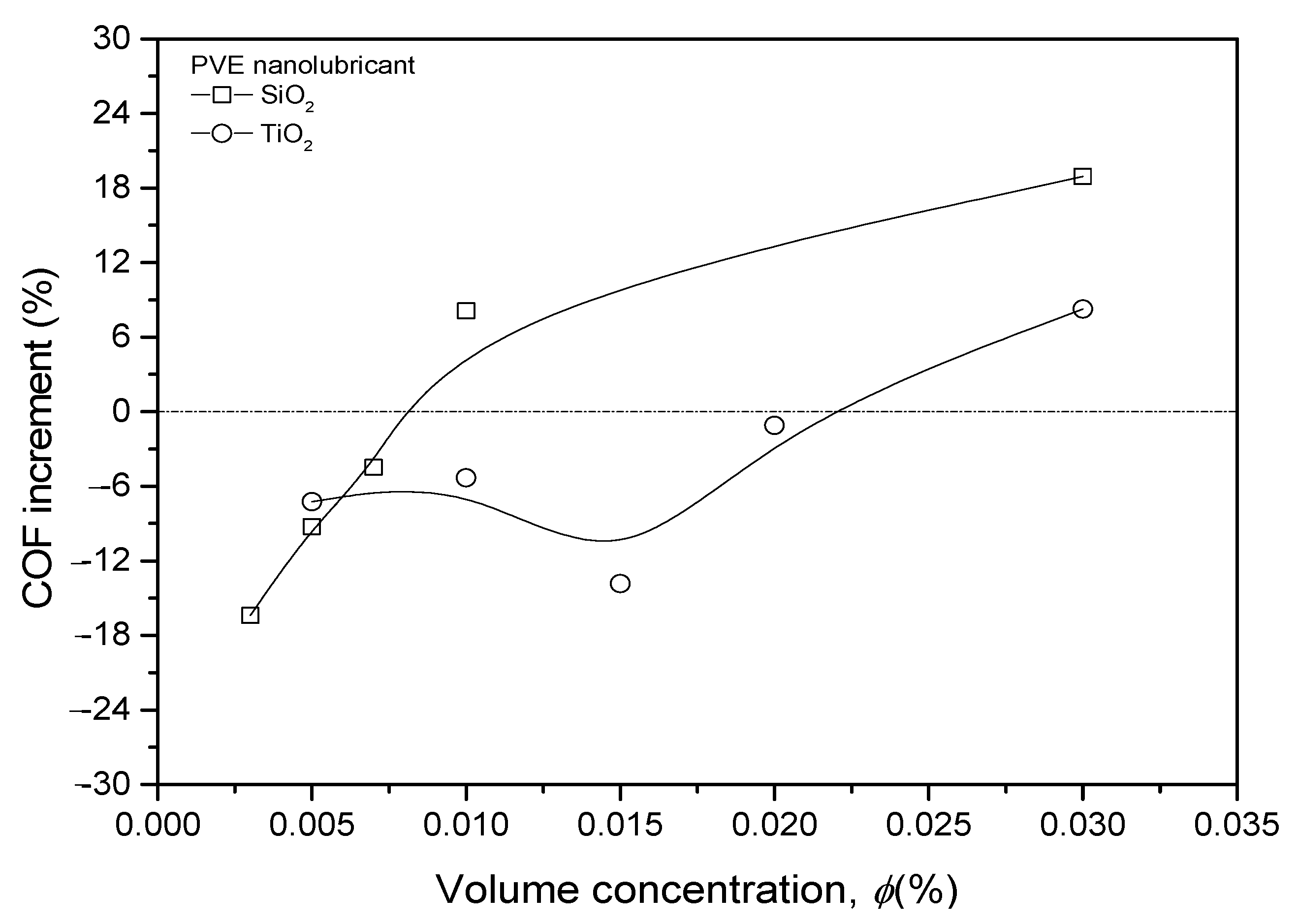


| Property | PVE |
|---|---|
| Dynamic Viscosity, mm2/s @ 40 °C | 68.1 |
| Dynamic Viscosity, mm2/s @ 100 °C | 8.04 |
| Viscosity index | 84 |
| Pour Point, °C | −37.5 |
| Flash point, °C | 204 |
| Density, kg/m3 @ 15 °C | 936.9 |
| Property | Nanoparticles | |
|---|---|---|
| SiO2 | TiO2 | |
| Density, [kg/m3] | 2220 | 4230 |
| Thermal conductivity, k [W/mK] | 4 | 8.4 |
| Molecular mass, M [g/mol] | 60.08 | 79.87 |
| Average diameter, [nm] | 15 | 30–50 |
| Specific surface area [m2/g] | 250 | - |
| Specific heat, cp [J/kgK] | 745 | 692 |
| Models | Correlations |
|---|---|
| Hamilton and Crosser [37] | |
| Redhwan et al. [18] | |
| Zawawi et al. [19] |
| Parameters | Accuracy | Values Measured | Uncertainty (%) | |
|---|---|---|---|---|
| Min | Max | |||
| Thermal conductivity, k [W/mK] | ±0.001 | 0.136 | 0.148 | 0.67–0.73 |
| Coefficient of friction, COF | ±0.001 | 0.091 | 0.139 | 0.72–1.09 |
| Nanolubricant | df | SS | MS | F | Significance F | |
|---|---|---|---|---|---|---|
| Regression | SiO2/PVE | 1 | 0.0005762 | 0.00058 | 7059.1402 | 5.07 × 10−41 |
| TiO2/PVE | 1 | 0.000584 | 0.000584 | 2520.0464 | 1.77 × 10−33 | |
| Residual | SiO2/PVE | 34 | 2.775 × 10−6 | 8.2 × 10−8 | ||
| TiO2/PVE | 34 | 7.879 × 10−6 | 2.32 × 10−7 | |||
| Total | SiO2/PVE | 35 | 0.0005789 | |||
| TiO2/PVE | 35 | 0.0005918 |
Disclaimer/Publisher’s Note: The statements, opinions and data contained in all publications are solely those of the individual author(s) and contributor(s) and not of MDPI and/or the editor(s). MDPI and/or the editor(s) disclaim responsibility for any injury to people or property resulting from any ideas, methods, instructions or products referred to in the content. |
© 2022 by the authors. Licensee MDPI, Basel, Switzerland. This article is an open access article distributed under the terms and conditions of the Creative Commons Attribution (CC BY) license (https://creativecommons.org/licenses/by/4.0/).
Share and Cite
Ismail, M.F.; Azmi, W.H.; Mamat, R.; Ali, H.M. Thermal and Tribological Properties Enhancement of PVE Lubricant Modified with SiO2 and TiO2 Nanoparticles Additive. Nanomaterials 2023, 13, 42. https://doi.org/10.3390/nano13010042
Ismail MF, Azmi WH, Mamat R, Ali HM. Thermal and Tribological Properties Enhancement of PVE Lubricant Modified with SiO2 and TiO2 Nanoparticles Additive. Nanomaterials. 2023; 13(1):42. https://doi.org/10.3390/nano13010042
Chicago/Turabian StyleIsmail, Mohd Farid, Wan Hamzah Azmi, Rizalman Mamat, and Hafiz Muhammad Ali. 2023. "Thermal and Tribological Properties Enhancement of PVE Lubricant Modified with SiO2 and TiO2 Nanoparticles Additive" Nanomaterials 13, no. 1: 42. https://doi.org/10.3390/nano13010042
APA StyleIsmail, M. F., Azmi, W. H., Mamat, R., & Ali, H. M. (2023). Thermal and Tribological Properties Enhancement of PVE Lubricant Modified with SiO2 and TiO2 Nanoparticles Additive. Nanomaterials, 13(1), 42. https://doi.org/10.3390/nano13010042







